Imagine standing at a crossroads, a map filled with confusing symbols in your hand. You’ve just been diagnosed with prediabetes or type 2 diabetes, and the path to managing your blood sugar feels like navigating a labyrinth. Carbohydrates, once a simple source of energy, now seem like a minefield of potential blood sugar spikes. You’re bombarded with conflicting advice, leaving you unsure which direction to take.
This guide is your compass.
We’ll unravel the mysteries of carbohydrates, revealing their impact on your body and empowering you to make informed choices. We’ll explore the science behind how carbs affect your blood sugar, debunk common myths, and provide practical strategies to navigate the world of carbohydrates with confidence. Get ready to conquer the sugar beast and reclaim your health!
Understanding the Carb Connection

Carbohydrates, along with fats and proteins, are one of the three macronutrients that fuel our bodies. They’re found abundantly in grains, fruits, vegetables, and dairy products. When we consume carbs, our bodies diligently break them down into glucose, a simple sugar that enters our bloodstream and raises blood sugar levels.
This process, while essential for energy production, can be tricky for individuals with diabetes. In type 2 diabetes, the body either struggles to produce enough insulin or becomes resistant to its effects. Insulin, a vital hormone, acts like a key, unlocking the doors of our cells to allow glucose to enter and provide energy. When insulin falters, glucose accumulates in the bloodstream, leading to high blood sugar levels.
Over time, persistent high blood sugar can damage blood vessels and nerves, increasing the risk of severe health complications like heart disease, stroke, kidney disease, and even vision loss. This is why managing carbohydrate intake is paramount for individuals with diabetes.
Insulin: The Gatekeeper of Glucose
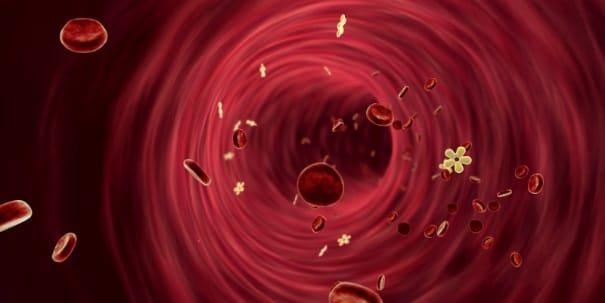
Picture insulin as a skilled gatekeeper, carefully regulating the flow of glucose into our cells. In healthy individuals, this process is seamless. When you eat carbohydrates, your pancreas releases just the right amount of insulin to match the incoming glucose, ensuring a smooth and efficient energy supply to your cells.
However, in type 2 diabetes, this well-coordinated system falters. The pancreas may not produce enough insulin, or your cells may become resistant to its signals, like a door that’s become jammed. Consequently, glucose struggles to enter the cells, leading to a buildup in the bloodstream.
This is where making informed carbohydrate choices becomes crucial. By focusing on carbs that have a gentler impact on blood sugar, you can support your body’s ability to manage glucose effectively and reduce the burden on your insulin production.
Decoding the Glycemic Index (GI) and Glycemic Load (GL)
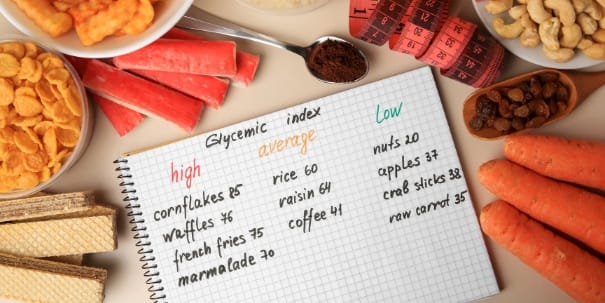
Two key concepts to grasp when making carbohydrate choices are the Glycemic Index (GI) and Glycemic Load (GL).
Glycemic Index (GI)
Imagine a race where different carb-containing foods compete to raise your blood sugar. The GI measures how quickly each food crosses the finish line. High-GI foods sprint ahead, causing a rapid spike in blood sugar, while low-GI foods take a more leisurely pace, resulting in a gradual rise.
- Low GI: A GI of 55 or less is considered low.
- Medium GI: A GI of 56-69 is considered medium.
- High GI: A GI of 70 or more is considered high.
Glycemic Load (GL)
This takes into account both the GI of a food and the amount of carbohydrates it delivers in a typical serving. It’s like considering both the speed of the runner and the weight they carry. The GL provides a more comprehensive picture of a food’s impact on your blood sugar.
- Low GL: A GL of 10 or less is considered low.
- Medium GL: A GL of 11-19 is considered medium.
- High GL: A GL of 20 or more is considered high.
While GI and GL are helpful tools, they don’t tell the whole story. Other factors, such as fiber content and cooking methods, can also influence a food’s effect on your blood sugar.
Glycemic Index and Glycemic Load of Common Foods:
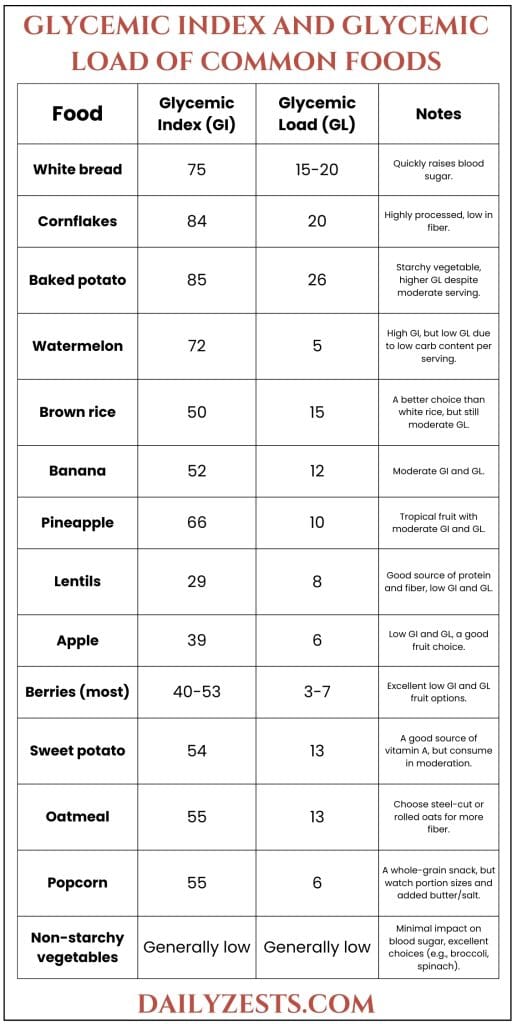
Navigating the Carb Landscape: Healthy Choices for Diabetes
Now that you understand how carbohydrates interact with your body, let’s explore the healthiest options for people with diabetes.
1. Vegetables: Your Nutritional Powerhouse

Vegetables are a nutritional goldmine, brimming with vitamins, minerals, fiber, and antioxidants. They’re naturally low in carbohydrates and calories, making them a cornerstone of a diabetes-friendly diet.
Prioritize non-starchy vegetables, such as:
- Leafy greens (spinach, kale, romaine lettuce)
- Broccoli
- Cauliflower
- Brussels sprouts
- Green beans
- Asparagus
- Bell peppers
- Onions
- Mushrooms
These vegetables have a minimal impact on your blood sugar and can be enjoyed liberally.
Starchy vegetables, like potatoes, corn, and peas, contain more carbohydrates and should be consumed in moderation.
2. Fruits: Nature’s Sweet Treats

Fruits offer a delightful array of flavors and nutrients, but they can also be high in natural sugars. Opt for low-glycemic fruits and savor them in moderation:
- Berries (strawberries, blueberries, raspberries)
- Cherries
- Apples
- Pears
- Grapefruit
Limit your intake of high-glycemic fruits like bananas, grapes, and mangoes.
Fruit juice is essentially a concentrated dose of sugar and should be avoided or consumed sparingly.
3. Whole Grains: A Fiber-Rich Choice
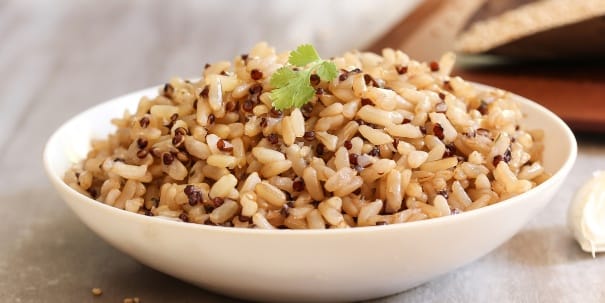
Whole grains provide valuable fiber, which can help regulate blood sugar levels. However, they still contain carbohydrates and should be consumed mindfully.
Always choose whole grains over refined grains. Look for breads, cereals, and pasta made with 100% whole grains.
Examples of whole grains:
- Brown rice
- Quinoa
- Oats
- Whole wheat bread
- Whole grain pasta
4. Beans and Legumes: Plant-Powered Protein

Beans and legumes are excellent sources of plant-based protein, fiber, and various nutrients. They’re relatively low in carbohydrates and have a low glycemic index.
Examples of beans and legumes:
- Lentils
- Black beans
- Kidney beans
- Chickpeas
5. Dairy: Choosing Wisely
Dairy products like milk and yogurt can be included in a healthy diabetes diet. Opt for low-fat or non-fat options and limit sweetened varieties.
Greek yogurt is a particularly good choice due to its higher protein and lower carbohydrate content compared to regular yogurt.
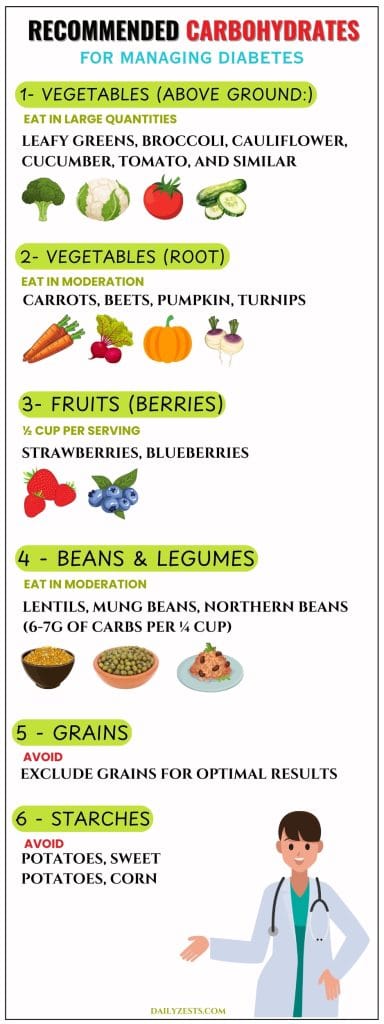
Carb Overload: A Common Dietary Pitfall
As we’ve discussed, carbohydrates are essential, but overconsumption, especially of the wrong kinds, can be detrimental, particularly for those with diabetes. Studies indicate that the average person consumes a staggering amount of carbohydrates – around 800 calories worth daily! This excessive intake can disrupt blood sugar balance and contribute to insulin resistance.
For individuals with diabetes or prediabetes, carbohydrates exert the most significant influence on blood sugar and A1c levels. Therefore, gaining control over your carb intake is crucial.
Let’s analyze a typical day on a Western diet to illustrate this point:
- Breakfast: Scrambled eggs with two slices of white toast and a glass of orange juice.
- Morning Tea: A small chocolate muffin.
- Lunch: A cheeseburger with french fries and a soda.
- Afternoon Tea: A cup of fruit-flavored yogurt.
- Dinner: Roasted chicken with 1/2 cup of white rice and a side of cooked vegetables.
- Dessert: A small slice of apple pie.
Nutritional Breakdown:

This example highlights the carb overload prevalent in many modern diets. It’s not just the sheer quantity but also the poor nutritional quality that raises concerns.
For many years, conventional advice for people with diabetes emphasized consuming more carbohydrates and reducing fats and proteins. This guidance, though well-intentioned, has proven counterproductive. As a person with diabetes, you essentially experience carbohydrate intolerance, meaning your body has difficulty processing glucose efficiently.
While individual tolerance levels vary, research consistently demonstrates that a lower-carb approach is most effective for managing blood sugar and A1c levels.
How Carbs Affect Your Body: A Closer Look
Let’s delve deeper into the fundamental process of how carbohydrates interact with your body:
- You eat carbohydrates: Whether it’s a slice of bread or a bowl of rice, your body begins to break down these carbs into glucose.
- Blood glucose rises: As glucose enters your bloodstream, your blood sugar levels naturally rise.
- Insulin is released: Your pancreas, sensing the increase in blood sugar, releases insulin to help transport glucose into your cells.
- Insulin resistance hinders glucose uptake: In diabetes, your cells may resist insulin’s signals, or your pancreas may not produce enough insulin. This leads to glucose remaining in the bloodstream instead of entering the cells.
- The cycle perpetuates: High blood glucose levels further exacerbate insulin resistance, creating a vicious cycle. Additionally, insulin promotes fat storage, so excess glucose gets pushed into fat cells, potentially contributing to weight gain and other health issues.
This process emphasizes the importance of choosing the right types of carbohydrates. Even complex carbs
Carb Counting and Portion Control

Keeping track of your carbohydrate intake can be incredibly helpful in managing your blood sugar levels. Here are some practical tips:
- Read Food Labels: Pay close attention to the serving size and the total carbohydrate content per serving.
- Measure Your Portions: Use measuring cups, a food scale, or visual guides to ensure you’re consuming accurate portion sizes.
- Spread Out Your Carbs: Distribute your carbohydrate intake throughout the day to help prevent blood sugar spikes.
- Pair Carbs with Protein and Fats: Combining carbohydrates with protein and healthy fats can help slow down glucose absorption and promote more stable blood sugar levels.
- Monitor Your Blood Sugar: Regularly checking your blood sugar levels, especially after meals, can provide valuable insights into how different foods affect you.
- Seek Professional Guidance: A registered dietitian or certified diabetes educator can help you create a personalized meal plan tailored to your specific needs and goals.
A Sample Meal Plan
To give you a better idea of how to incorporate these principles into your daily life, here’s a sample meal plan:
Breakfast:
- Scrambled eggs with spinach and mushrooms
- A side of berries
Lunch:
- Large salad with grilled chicken or fish
- Mixed greens, cucumber, tomatoes, avocado, and a vinaigrette dressing
Dinner:
- Salmon with roasted broccoli and a small serving of quinoa
Snacks:
- A handful of almonds
- Carrot sticks with hummus
- Plain Greek yogurt with a sprinkle of cinnamon
Remember, this is just a sample meal plan. It’s essential to work with a healthcare professional to create a plan that aligns with your individual needs and preferences.
Beyond Diet: A Holistic Approach to Diabetes Management

While a healthy diet is a cornerstone of diabetes management, it’s not the only factor to consider. Here are other essential elements to incorporate into your lifestyle:
Regular Physical Activity
Exercise plays a crucial role in improving insulin sensitivity and helping your body utilize glucose more effectively. Aim for at least 30 minutes of moderate-intensity exercise most days of the week. This could include brisk walking, cycling, swimming, or dancing.
Weight Management
If you’re overweight or obese, losing even a small amount of weight can significantly enhance your blood sugar control and reduce your risk of diabetes-related complications.
Stress Management
Chronic stress can wreak havoc on your blood sugar levels. Explore stress-reducing techniques such as yoga, meditation, deep breathing exercises, or spending time in nature.
Regular Checkups and Monitoring
Regular visits to your doctor are crucial for monitoring your blood sugar control, assessing any complications, and adjusting your treatment plan as needed.
Your Path to Empowerment
Managing diabetes is a journey, not a destination. It requires ongoing attention and commitment, but it’s a journey you don’t have to take alone. With the right knowledge, support, and a proactive mindset, you can navigate the complexities of carbohydrates, maintain healthy blood sugar levels, and live a full and vibrant life.
Remember, it’s not about deprivation or rigid restrictions. It’s about making informed choices, prioritizing nutrient-dense foods, and finding a sustainable approach that works for you. Embrace the abundance of healthy options, savor your meals mindfully, and celebrate your progress along the way.
You’ve got this!
Master the art of managing carbs and take control of your diabetes journey! If this guide helped you, share it on Pinterest to empower others with the keys to healthy blood sugar. 📌✨

Resources:
- The Effect of a Low-Carbohydrate, Ketogenic Diet on Glycemic Control in Type 2 Diabetes Mellitus
- Efficacy of Low-Carbohydrate Diet for Type 2 Diabetes Mellitus Management: A Systematic Review and Meta-Analysis of Randomized Controlled Trials
- Effect of a Moderate or Low Carbohydrate Diet in Type 2 Diabetes: A Meta-Analysis of Randomized Trials
- Low-Carbohydrate Diets for the Management of Obesity and Type 2 Diabetes
- Long-Term Effects of a Novel Continuous Remote Care Intervention Including Nutritional Ketosis for the Management of Type 2 Diabetes: A 2-Year Non-randomized Clinical Trial
- The American Diabetes Association’s 2023 Standards of Care in Diabetes
- Dietary carbohydrate restriction as the first approach in diabetes management: Critical review and evidence base
- Management of Type 2 Diabetes: A Pragmatic Approach

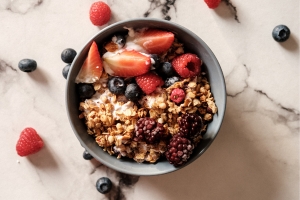





12 Responses
This article is really informative, but I’m a bit overwhelmed by all the information about GI and GL. It seems like a lot to keep track of on top of everything else. Are there any simple rules of thumb I can follow without having to constantly look up the GI and GL of every single food? Also, you mentioned that the average person consumes around 800 calories of carbohydrates daily. Could you please provide some statistics on how this differs between racial groups? I’m curious to see if there are any significant disparities.
Hi Jennifer, thanks for your comment! I understand that GI and GL can seem daunting at first. A good rule of thumb is to focus on whole, unprocessed foods as much as possible. Think vegetables, lean proteins, and healthy fats. When choosing carbs, opt for non-starchy vegetables, berries, and whole grains in moderation. Don’t get too bogged down in the numbers – just aim for a balanced plate with plenty of fiber. Regarding your question about carbohydrate consumption and racial groups, research shows disparities. For instance, data from the CDC’s National Health and Nutrition Examination Survey (NHANES) indicates that non-Hispanic Black adults in the U.S. consume an average of 850 calories from carbohydrates daily, while non-Hispanic white adults consume around 780 calories. Moreover, Hispanic adults consume approximately 820 calories from carbohydrates daily. These differences can be influenced by various cultural and socioeconomic factors. It is important to note that these are averages, and individual intake can vary widely within each group. Also, the American Diabetes Association highlights that diabetes disproportionately affects certain racial and ethnic groups, including Black, Hispanic, American Indian, and Asian American populations. Focusing on culturally relevant dietary education can be beneficial.
I’ve been trying to follow a low-carb diet, but I find it really difficult to stick to, especially when eating out or at social events. It feels very restrictive. Do you have any tips for making it more sustainable in the long run? Also, I’ve heard conflicting information about artificial sweeteners. Are they a good alternative for people with diabetes, or are they harmful?
Hi Sarah, you’re not alone! Many people find low-carb diets challenging to maintain long-term. The key is to find a balance that works for you and doesn’t feel overly restrictive. Instead of completely eliminating carbs, try reducing your intake gradually and focusing on the quality of the carbs you eat. When eating out, look for options that are naturally lower in carbs, like grilled meats or fish with vegetables. Don’t be afraid to ask for modifications, like swapping out fries for a side salad. For social events, offer to bring a healthy dish that you know you can enjoy. As for artificial sweeteners, the research is mixed. Some studies suggest they may have negative effects on gut health and metabolism, while others show no significant harm. The American Diabetes Association considers them safe in moderation, but they are not necessarily beneficial. It is generally best to limit them and focus on whole, unprocessed foods. If you do use them, do so sparingly. Ultimately, it’s about finding a sustainable and enjoyable way of eating that supports your health goals.
Okay, so carbs are like the villains and heroes of the food world, depending on who you ask! This article is helpful in clearing up some of the confusion. I’m especially interested in the Glycemic Index and Load. It sounds like a video game scoring system for food! But seriously, how do you remember which foods are high or low? Is there a cheat sheet or something? I don’t want to carry around a GI encyclopedia in my purse! Also, you mention portion control – does that mean I can still have a small piece of cake on my birthday? Asking the important questions here!
Hi Mary, thanks for your comment! I love the video game analogy – it definitely makes thinking about GI and GL more fun! Remembering all the numbers can be tricky, but you don’t need an encyclopedia. Here are a few tips:
Focus on food groups: Generally, whole, unprocessed foods like non-starchy vegetables, most fruits, and whole grains tend to be lower on the GI scale. Processed foods, sugary drinks, and refined grains are usually higher.
Fiber is your friend: Foods high in fiber tend to have a lower GI because fiber slows down digestion and the absorption of sugar.
Use online resources: There are many websites and apps that provide GI and GL information for various foods. You can easily look up a food if you’re unsure.
And yes, portion control is key! It doesn’t mean you have to completely deprive yourself. A small piece of cake on your birthday is perfectly fine! The key is to be mindful of the portion size and balance it with other healthy choices. Enjoy your cake, but maybe skip the extra sugary toppings or pair it with a protein source to help slow down the sugar absorption. It’s all about balance and moderation!
This article is informative. I’m newly diagnosed with prediabetes, and I’m trying to wrap my head around all the dietary changes. This explanation of how carbs affect blood sugar is really helpful. I’m a big fan of fruit, though, and I’m a little sad to see some of my favorites on the “limit” list. You mention berries being a good choice. Are frozen berries okay, too? Also, about the sample meal plan: it looks pretty healthy, but it seems like it requires a lot of cooking. Are there any quick and easy meal ideas for busy weeknights? I barely have time to breathe, let alone cook elaborate meals!
Hi Patricia, thanks for your comment! It’s understandable to feel overwhelmed when first diagnosed with prediabetes, but you’re taking the right steps by educating yourself. Yes, frozen berries are absolutely fine! They’re just as nutritious as fresh berries and often more convenient. They’re also great for smoothies!
Regarding quick and easy meal ideas, I totally understand the busy weeknight struggle. Here are a few ideas that require minimal cooking:
Salads with pre-cooked protein: Use pre-cooked grilled chicken, canned tuna or salmon, or hard-boiled eggs for a quick and easy protein boost. Add lots of non-starchy vegetables and a healthy dressing (like olive oil and vinegar).
One-pan meals: Roast vegetables and protein (like chicken or tofu) on a single baking sheet for easy cleanup.
Quick stir-fries: Use pre-cut vegetables and a quick stir-fry sauce for a fast and healthy meal.
Soup and salad: Pair a quick and easy soup (like lentil soup or tomato soup) with a simple salad.
Overnight oats: Prepare oatmeal the night before and grab it on your way out the door in the morning.
There are also many healthy meal delivery services or meal prep companies that can help you save time on cooking. Remember, even small changes can make a big difference, so don’t feel like you have to overhaul your entire diet overnight. Start with small, manageable steps, and gradually incorporate more healthy habits into your routine.
This is all very informative, but it feels a little overwhelming. I love my bread, I love my pasta, and I love my occasional sweet treat! The article mentions that the average person consumes about 800 calories of carbs a day. Is that really so bad? And what about different types of people? Do these recommendations apply equally to everyone, regardless of their background or ethnicity? I’ve heard that some cultures traditionally eat more carbs than others. Also, can you share some statistics on how effective these methods are?
Hi Oprah, you bring up some excellent points! It can definitely feel overwhelming to overhaul your diet, and nobody wants to give up all their favorite foods. The 800-calorie figure is an average, and while it might not be “bad” for everyone, it’s significantly higher than what’s generally recommended for someone managing diabetes or prediabetes. Studies have shown that reducing carb intake can be very effective. For example, a meta-analysis published in the journal Nutrients found that low-carb diets significantly improved glycemic control in people with type 2 diabetes. The American Diabetes Association also supports a lower-carb approach as one effective strategy for managing diabetes. For example, research suggests that African Americans may have a higher risk of developing type 2 diabetes, and studies have shown that culturally tailored dietary interventions, which may include modified carb recommendations, can be beneficial. A 2017 study published in the journal Diabetes Care found that African American adults with type 2 diabetes who followed a low-carbohydrate diet experienced significant improvements in blood sugar control and weight loss.
A study published in the journal Ethnicity & Disease highlighted that Asian Americans also have a higher risk, and traditional high-carb diets may play a role. It’s not about eliminating carbs altogether, but rather about being mindful of the quantity and quality. And you’re right to point out cultural differences. Traditional diets vary greatly, and recommendations should be tailored. For example, someone accustomed to a diet rich in rice might focus on portion control and choosing brown rice over white, rather than eliminating rice completely. It’s about finding a balance that respects cultural traditions while supporting health goals. The key is working with a healthcare professional or a registered dietitian to create a personalized plan that fits your individual needs, preferences, and cultural background. And yes, you can still enjoy those occasional treats – just factor them into your overall plan!
Well, bless your heart for trying to make all this carb talk a little easier to swallow! But honey, let’s be real, some of us have a sweet tooth that just won’t quit. Are there any low-carb desserts that actually taste good? Or are we stuck with, as you say, just fruit and yogurt? And what about eating out? Restaurants aren’t always the most accommodating when it comes to special diets. Any tips for navigating a menu when you’re trying to be good?
Hi Dolly, you know I’d never leave you without a sweet treat option! There are actually tons of delicious low-carb dessert recipes out there that use alternative sweeteners and ingredients like almond flour or coconut flour. Think decadent chocolate mousse made with avocado, or cheesecake made with a nut-based crust. You can find amazing recipes online! And as for eating out, it can be tricky, but it’s definitely doable. Most restaurants are getting better at accommodating dietary needs. Don’t be afraid to ask your server about low-carb options or modifications. For example, you can often order a burger without the bun, or ask for extra veggies instead of fries. Salads are usually a good bet, but watch out for sugary dressings – ask for it on the side. And remember, it’s okay to indulge every now and then. Just plan for it, enjoy it, and get back on track with your next meal. Life’s too short to skip all the fun, right?